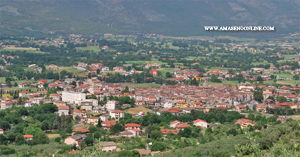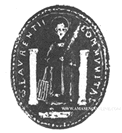|

History
of Amasen
 istory
of Amaseno istory
of Amaseno
Descriptive signs,
Historic signs,
Demographic movement

ntroduction
Amaseno has the
fortune of possessing lots of art treasures and a
history rich in religious, medieval and civil
memories it is worth to know about. The first person
to write about Amaseno's history and to bring into
light its important monuments was Giuseppe
Tomassetti, well known Roman archaeologist and
historian (1848-1911), who was given the job by Ecc.mi
Mons. Diomede e Agapito Panici.
The job was not easy
because it was necessary to start from scratch; but
Tomassetti well knew where to get the relevant
documents. He explored different files, especially
the Casa Colonna's file, which hi had previously
tidied up, the Vatican and Ferentino's secret files
and three of the local ones. With lots of patience,
Tomassetti decoded and copied again the antique
papers worn out and yellowed by age. His work was
published in Rome by the Unione Cooperativa Editrice
in 1897.
Since then many
years have gone by and the few original published
copies can now only be found in major national
libraries. Of course, in recent years other facts
have taken place and other documents have been
discovered . It is therefore necessary to complete
and update the Tomassetti's work and that's why we
have included an appendix as a summary of Amaseno's
history and its monuments; we want everybody to know
about our treasures, about a land which became
famous by the miracle of San Lorenzo’s blood.
Back to top
 escriptive
signs
Amaseno
is in the Lazio region, 110 Km south of Rome, and it
is situated precisely on the upper valley of its
river also called Amaseno. It is surrounded, in an
amphitheatre-look alike, by the Lepini and Ausoni
mountains with their highestpeak, Monte delle Fate,
reaching 1090 meters.
You can get access
to the city from the motorway in two directions:
from Pianura Pontina, going through Priverno (17
Km), and from Castro dei Volsci going trough
Vallefratta (8,4 Km). It is also possible to get
here from Fondi through Vallecorsa. Amaseno's
territory is one of the widest in the Frosinone
province 77 square km. Nearby cities are Villa S.
Stefano, Castro dei Volsci, Vallecorsa, Monte S.
Biagio, Sonnino, Roccasecca dei Volsci and Prossedi.
There are over 4.000 inhabitants in Amaseno, mostly
farmers living in the countryside.
The vegetation is
typical of the Mediterranean climate, ranging from
sage, holm oak, oak and olive trees. The main
products are cereals, olive oil, pulses, vegetables,
tobacco, wood and animals. There are 36 water
springs counted so far in Amaseno, the biggest one
being Capo d'acqua. Experts from the Universita' di
Roma have analysed the water and stated that it is
very good to drink, it's pure, light, helps
digestion and so it is good for your well-being.
Water is mainly used in agriculture and also feeds
the Amaseno river or, as Virgilio would call it, the
«Amasene pater» and
«Amasenus abundans» (En. VII, 685;XI,547).
The historic centre
is situated on a hill at 112 m. from sea level
nearby M. Civitella. It has medieval characteristics
with a surrounding wall and a feudal castle. Houses
are made of dark limestone, quite simple and of
rustic appearance. Here and there you can see 18th
century buildings with elegant doors and windows.
The streets are narrow with cobbled surfaces; two
squares open in front of San Pietro and Santa Maria
found on the opposite sides of the city. There are
five access doors to the historic centre: Porta S.
Maria, Porta del Cauto, Porta del Colle, Porta di
Marco Testa, Porta Nova. Outside the wall there are
pretty modern constructions such as the counsel
building, the war monument, the school building a
varies private homes.
Back to top
 istoric
signs
Research shows that
there is no proof that Amaseno is of Roman origin.
Furthermore, it's position is not one of a safe and
strategic place typical in Roman time. Bertarelli
and other historians back the idea that Amaseno was
set up in eight hundred AD in the surroundings of a
monk's abbey, typical of other medieval cities. At
that time barbaric invasions were a real threat to
people and the abbey was seen as the safest place to
be. Soon people started to get organised, build new
houses and infrastructures.

Amaseno valley
The first documented news about Amaseno dates back
to the first millennium, when the city was called
«S. Lorenzo»
and the valley known as «Valle di S. Lorenzo», as
registered in the Tabularium Cassinense (Tom.1,pag.228,a.1025).
From the Annales Ceccanenses we know that Amaseno,
that is S. Lorenzo, was the property of the Conti di
Ceccano (Earls of Ceccano), and that after bloody
fighting it became the pope's property. In 1165 the
war between Federico I called Barbarossa and pope
Alessandro III ended up with the sacking and burning
of the entire city.
In 1208 S. Lorenzo
had the honour to guest for a day the then famous
pope Innocenzo III in his castle. Later in 1419, the
city was taken by Queen Giovanna II of Naples, which
she gave to Princes Colonna and to Princes Caetani
in the successive years. Then followed a dispute of
the city between the two families that lasted nearly
two centuries. In 1591, S. Lorenzo was finally given
to Princes Colonna who reigned till 1816, i.e. the
abolition of the old system.
The seventeenth and
the eighteenth centuries saw prosperity and serenity
among the people but at the beginning of the
successive century all that changed. The conquer of
the peninsula by French troops and their new ideas
of liberty and democracy, brought political
instability with it. The fighting for the power
generated rebellion among people and bandits were
spreading everywhere.
In 1870, with the
occupation of Lazio and Rome the State of Italy was
finally born. The anti-papal feeling came into light
and the new local councillors decided then to change
the name of
«S. Lorenzo» to «Amaseno», it's river's name.
However, the spiritual site of most people remained
untouched and they are still now very religious.

Coat of arms the village when it was called
San Lorenzo
During the great wars many men left their families
to fight the enemies; most of them died while others
were brought to the concentration camps. In the
second world war civilians had to hide themselves on
the mountains after the spread of violence incurred
by the Allied forces, suffering starvation and
deprivations.
Back to top
 emographic
movement
The population of
Amaseno has changed over the centuries. We could say
that around one hundred people lived in the
surroundings of the monk's abbey, as craftsmen and
farmers. The number increased when more land was
reclaimed from the valley.
The oldest document
on the matter dates back to 1593 and can be found in
Santa Maria’s church. The then priest D. Domenico
Rotondi counted 166 families and 755 people. In 1654
the population went down to 577 due to the spreading
of plague. Unfortunately, no similar document has
been found in the other major church, i.e. San
Pietro’s church, so we cannot say for sure how many
people used to live in Amaseno.
According to the
council's census, at the end of the last century the
number of inhabitants raised to 2965. The population
reached its high in 1958 with 4.592 registered. The
rise in number was mainly due to people living in
nearby Vallecorsa settling on the other side of the
mountains. In recent years there has been a steady
decrease in numbers due to emigration.
Translated by Mauro Rotondi & Beverley
Wheatley
|